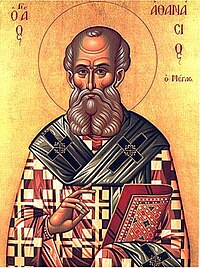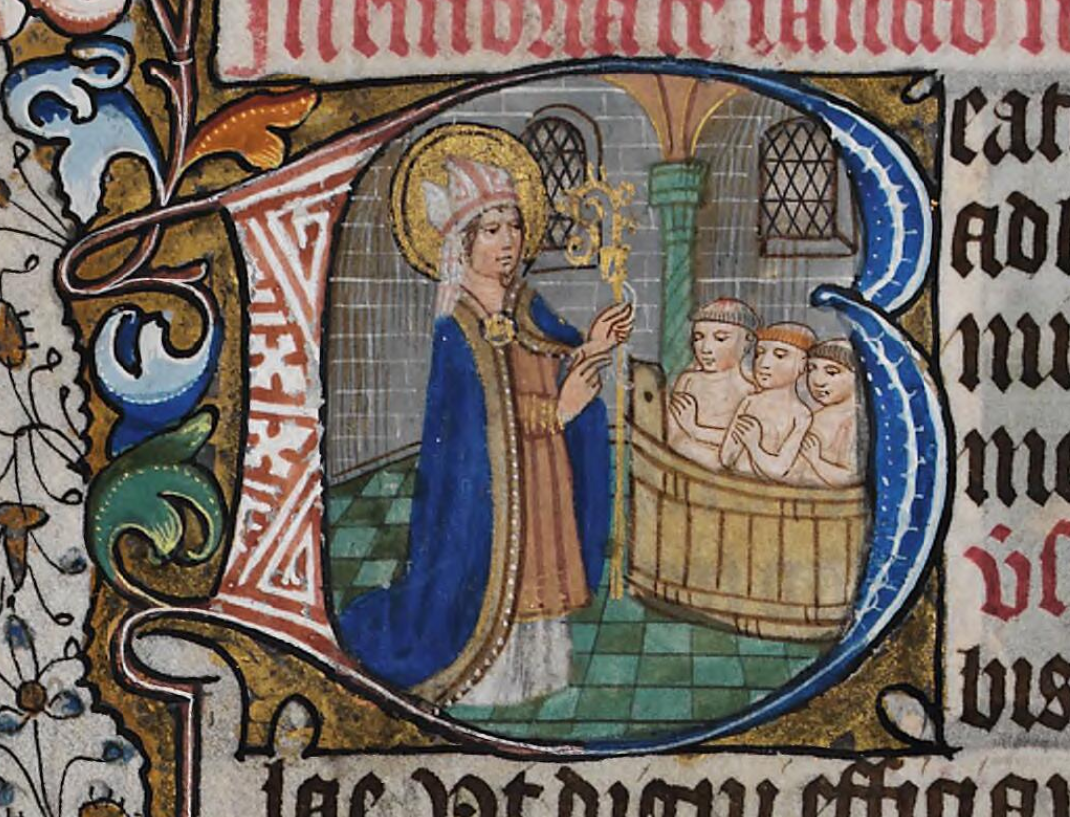Today is the memorial of St Alphonsus Mary de Liguorni (1696 – 1787), founder of the Redemptorists, so you might particularly say a prayer for his Order, and particularly for the Sons of the Holy Redeemer, trying to keep alive the traditional expression of that charism.
Pope Benedict XVI gave a
General Audience on the saint earlier this year:
"Today I would like to present to you the figure of a holy Doctor of the Church to whom we are deeply indebted because he was an outstanding moral theologian and a teacher of spiritual life for all, especially simple people. He is the author of the words and music of one of the most popular Christmas carols in Italy and not only Italy: Tu scendi dalle stelle [You come down from the stars].
Belonging to a rich noble family of Naples, Alfonso Maria de’ Liguori [known in English as Alphonsus Liguori] was born in 1696. Endowed with outstanding intellectual qualities, when he was only 16 years old he obtained a degree in civil and canon law. He was the most brilliant lawyer in the tribunal of Naples: for eight years he won all the cases he defended. However, in his soul thirsting for God and desirous of perfection, the Lord led Alphonsus to understand that he was calling him to a different vocation. In fact, in 1723, indignant at the corruption and injustice that was ruining the legal milieu, he abandoned his profession — and with it riches and success — and decided to become a priest despite the opposition of his father.
He had excellent teachers who introduced him to the study of Sacred Scripture, of the Church history and of mysticism. He acquired a vast theological culture which he put to good use when, after a few years, he embarked on his work as a writer.
He was ordained a priest in 1726 and, for the exercise of his ministry entered the diocesan Congregation of Apostolic Missions. Alphonsus began an activity of evangelization and catechesis among the humblest classes of Neapolitan society, to whom he liked preaching, and whom he instructed in the basic truths of the faith. Many of these people, poor and modest, to whom he addressed himself, were very often prone to vice and involved in crime. He patiently taught them to pray, encouraging them to improve their way of life.
Alphonsus obtained excellent results: in the most wretched districts of the city there were an increasing number of groups that would meet in the evenings in private houses and workshops to pray and meditate on the word of God, under the guidance of several catechists trained by Alphonsus and by other priests, who regularly visited these groups of the faithful. When at the wish of the Archbishop of Naples, these meetings were held in the chapels of the city, they came to be known as “evening chapels”. They were a true and proper source of moral education, of social improvement and of reciprocal help among the poor: thefts, duels, prostitution ended by almost disappearing.
Even though the social and religious context of the time of St Alphonsus was very different from our own, the “evening chapels” appear as a model of missionary action from which we may draw inspiration today too, for a “new evangelization”, particularly of the poorest people, and for building a more just, fraternal and supportive coexistence. Priests were entrusted with a task of spiritual ministry, while well-trained lay people could be effective Christian animators, an authentic Gospel leaven in the midst of society.
After having considered leaving to evangelize the pagan peoples, when Alphonsus was 35 years old, he came into contact with the peasants and shepherds of the hinterland of the Kingdom of Naples. Struck by their ignorance of religion and the state of neglect in which they were living, he decided to leave the capital and to dedicate himself to these people, poor both spiritually and materially. In 1732 he founded the religious Congregation of the Most Holy Redeemer, which he put under the protection of Bishop Tommaso Falcoia, and of which he subsequently became the superior.
These religious, guided by Alphonsus, were authentic itinerant missionaries, who also reached the most remote villages, exhorting people to convert and to persevere in the Christian life, especially through prayer. Still today the Redemptorists, scattered in so many of the world’s countries, with new forms of apostolate continue this mission of evangelization. I think of them with gratitude, urging them to be ever faithful to the example of their holy Founder.
Esteemed for his goodness and for his pastoral zeal, in 1762 Alphonsus was appointed Bishop of Sant’Agata dei Goti, a ministry which he left, following the illness which debilitated him, in 1775, through a concession of Pope Pius VI. On learning of his death in 1787, which occurred after great suffering, the Pontiff exclaimed: “he was a saint!”. And he was not mistaken: Alphonsus was canonized in 1839 and in 1871 he was declared a Doctor of the Church. This title suited him for many reason. First of all, because he offered a rich teaching of moral theology, which expressed adequately the Catholic doctrine, to the point that Pope Pius XII proclaimed him “Patron of all confessors and moral theologians”.
In his day, there was a very strict and widespread interpretation of moral life because of the Jansenist mentality which, instead of fostering trust and hope in God’s mercy, fomented fear and presented a grim and severe face of God, very remote from the face revealed to us by Jesus. Especially in his main work entitled Moral Theology, St Alphonsus proposed a balanced and convincing synthesis of the requirements of God’s law, engraved on our hearts, fully revealed by Christ and interpreted authoritatively by the Church, and of the dynamics of the conscience and of human freedom, which precisely in adherence to truth and goodness permit the person’s development and fulfilment.
Alphonsus recommended to pastors of souls and confessors that they be faithful to the Catholic moral doctrine, assuming at the same time a charitable, understanding and gentle attitude so that penitents might feel accompanied, supported and encouraged on their journey of faith and of Christian life.
St Alphonsus never tired of repeating that priests are a visible sign of the infinite mercy of God who forgives and enlightens the mind and heart of the sinner so that he may convert and change his life. In our epoch, in which there are clear signs of the loss of the moral conscience and — it must be recognized — of a certain lack of esteem for the sacrament of Confession, St Alphonsus’ teaching is still very timely.
Together with theological works, St Alphonsus wrote many other works, destined for the religious formation of the people. His style is simple and pleasing. Read and translated into many languages, the works of St Alphonsus have contributed to molding the popular spirituality of the last two centuries. Some of the texts can be read with profit today too, such as The Eternal Maxims, the Glories of Mary, The Practice of Loving Jesus Christ, which latter work is the synthesis of his thought and his masterpiece.
He stressed the need for prayer, which enables one to open oneself to divine Grace in order to do God’s will every day and to obtain one’s own sanctification. With regard to prayer he writes: “God does not deny anyone the grace of prayer, with which one obtains help to overcome every form of concupiscence and every temptation. And I say, and I will always repeat as long as I live, that the whole of our salvation lies in prayer”. Hence his famous axiom: “He who prays is saved” (Del gran mezzo della preghiera e opuscoli affini. Opere ascetiche II, Rome 1962, p. 171).
In this regard, an exhortation of my Predecessor, the Venerable Servant of God John Paul II comes to mind. “our Christian communities must become genuine ‘schools’ of prayer…. It is therefore essential that education in prayer should become in some way a key-point of all pastoral planning” (Apostolic Letter Novo Millennio Ineunte, nn. 33, 34).
Among the forms of prayer fervently recommended by St Alphonsus, stands out the visit to the Blessed Sacrament, or as we would call it today, “adoration”, brief or extended, personal or as a community, before the Eucharist. “Certainly”, St Alphonsus writes, “amongst all devotions, after that of receiving the sacraments, that of adoring Jesus in the Blessed Sacrament takes the first place, is the most pleasing to God, and the most useful to ourselves…. Oh, what a beautiful delight to be before an altar with faith… to represent our wants to him, as a friend does to a friend in whom he places all his trust” (Visits to the Most Blessed Sacrament and to the Blessed Virgin Mary for Each Day of the Month. Introduction).
Alphonsian spirituality is in fact eminently Christological, centred on Christ and on his Gospel. Meditation on the mystery of the Incarnation and on the Lord’s Passion were often the subject of St Alphonsus’ preaching. In these events, in fact, Redemption is offered to all human beings “in abundance”. And precisely because it is Christological, Alphonsian piety is also exquisitely Marian. Deeply devoted to Mary he illustrates her role in the history of salvation: an associate in the Redemption and Mediatrix of grace, Mother, Advocate and Queen.
In addition, St Alphonsus states that devotion to Mary will be of great comfort to us at the moment of our death. He was convinced that meditation on our eternal destiny, on our call to participate for ever in the beatitude of God, as well as on the tragic possibility of damnation, contributes to living with serenity and dedication and to facing the reality of death, ever preserving full trust in God’s goodness.
St Alphonsus Maria Liguori is an example of a zealous Pastor who conquered souls by preaching the Gospel and administering the sacraments combined with behaviour impressed with gentle and merciful goodness that was born from his intense relationship with God, who is infinite Goodness. He had a realistically optimistic vision of the resources of good that the Lord gives to every person and gave importance to the affections and sentiments of the heart, as well as to the mind, to be able to love God and neighbour.
To conclude, I would like to recall that our Saint, like St Francis de Sales — of whom I spoke a few weeks ago — insists that holiness is accessible to every Christian: “the religious as a religious; the secular as a secular; the priest as a priest; the married as married; the man of business as a man of business; the soldier as a soldier; and so of every other state of life” (Practica di amare Gesù Cristo. Opere ascetiche [The Practice of the Love of Jesus Christ] Ascetic Works 1, Rome 1933, p. 79).
Let us thank the Lord who, with his Providence inspired saints and doctors in different times and places, who speak the same language to invite us to grow in faith and to live with love and with joy our being Christians in the simple everyday actions, to walk on the path of holiness, on the path towards God and towards true joy. Thank you."
Up until midnight tonight you can also obtain the portiuncula indulgence by visiting a Franciscan sanctuary, or one’s parish church, and reciting the Creed and Our Father (as well as the meeting the normal conditions for an indulgence).







